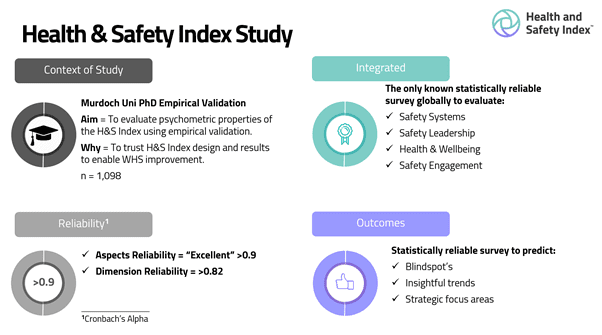It is no coincidence, Human Resource / People & Culture experts have successfully measured employee engagement for many years. So why not use surveys to measure health and safety performance?
Engagement, as a lead indicator for predicting culture, is often more reliable when conducting climate surveys. Changes in engagement are far more dynamic, whereas culture often takes many years to shift. We have designed an assessment tool that combines engagement, health and also safety aspects to provide a more immediate understanding of worker sentiment and areas of focus.
Furthermore, understanding the relationship between health, safety and employee engagement helps organisations measure, focus and act on improvements that matter!
INDEPENDENT REVIEW
We engaged a PhD (OrgPsych) from Murdoch University, to independently evaluate psychometric properties of the Health and Safety Index.
The principle findings of this analysis showed the reliability within the 4 aspects to be equal or greater than 0.9 or “excellent”.
As a result, this provides organisations confidence to use the Health and Safety Index as a reliable and repeatable measure. Survey questions have also been statistically correlated and linked to “Outcomes”, which provides a valid assessment and supports predictive survey results.
Organisations can use these Health and Safety Index results to support planning and strategic choices. In particular, business specific demographic data unique to each organisations can be applied to help evaluate and target specific areas of focus, e.g. specific positions, locations and business units.
Rather than applying a broad scatter gun approach, results from the Health and Safety Index support a targeted use of resources and a positive Return on Investment (ROI).

Safety Culture Surveys often provide an assessment of organisation’s safety climate, e.g. attitudes, beliefs, symbols, values and perceptions. There is extensive evidence of safety climate impacting on safety performance (5).
We believe there are many health & safety interdependencies that support a high performance culture. For this reason, we have designed an integrated set of 4 Aspects covering:
Rather than evaluating each Aspect in isolation, we take a wholistic view to understand interdependencies and evaluate these lead indicators impacting on organisational culture.
We believe there is a strong relationship between workplace health & safety performance and employee engagement. For this reason, we have integrated separate set of n=20 employee engagement questions and n=20 safety engagement questions into our assessment.
Measuring employee and safety engagement helps understand the levels of psychological safety and discretionary effort impacting on organisation culture (3).
We believe in a balanced approach between WHS systems and other practices when allocating resources to create effective engagement and a high performance culture (4).
We have integrated several safety systems into the Health and Safety Index mapped against key elements of ISO 45001, the international standard for management systems of occupational health and safety.
Unlike a traditional ISO audits, the Health and Safety Index evaluates User Experience (UX) to help organisations measure, focus and act on improvements that matter!
Health and wellbeing is a broad topic with many interdependencies across workplace safety, individual safety, systems and employee engagement (1).
Our integrated approach in designing the Health and Safety Index, applied principles from leading research to understand workplace psychosocial risk factors including:
Understanding the relationship between safety engagement, leadership behaviours, systems and health & wellbeing, enables organisations to measure, focus and act on improvements that matter!
INFORMATION SECURITY
All Health and Safety Index data is stored domestically in Australia on a secure cloud based platform to ensure effective information security management. In addition, our survey platform information security controls have been evaluated and registered as an approved supplier across several government agencies.
PRIVACY
At the Health and Safety Index, we respect the privacy organisation and personal data. We also abide by legal and other requirements.
For additional information, read our Data Privacy Statement.